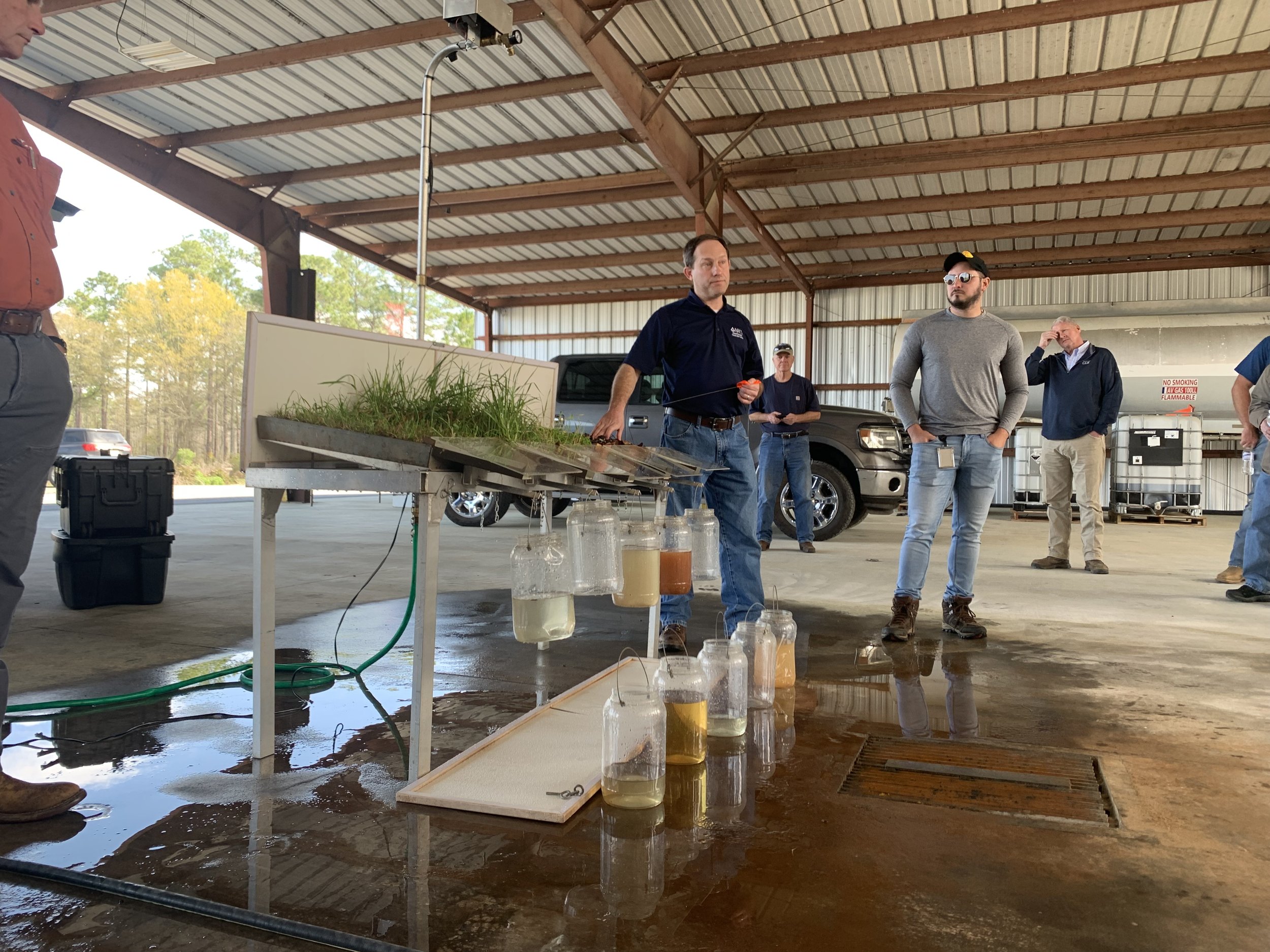Field Day Explores Sustainability, Highlights Soil Health, Irrigation Water Management, and Nitrogen Application Practices
On March 13, the Flint River Soil and Water Conservation District (FRSWCD) in partnership with Golden Peanut Company held a Soil Health Field Day on McLendon Acres, Inc. in Leary, Georgia.
“It was so great to get back to McLendon Acres for a second annual event highlighting innovative practices and programs to improve soil health in southwest Georgia,” says Perri Cooper, Flint River Soil and Water Conservation District Executive Director. “Not only do we get to hear from researchers and technical service providers, but directly from farmers on the forefront of adopting these soil health practices.”
Soil Health refers to the ability for soil to perform its functions and how they are being preserved for future use. This term encompasses many practices on the farm, including planting cover crops, reducing soil disturbance, preventing erosion, and more. 56 attendees, ranging from local farmers, USDA personnel, UGA Extension representatives, and other conservation stakeholders convened to learn about the latest research in soil health, learn about cost-share programs, and to see soil health in practice.
Host farmer Adam McLendon kicked off the field day with an overview on his farm practices. “We’re fond of cover cropping and plant about 4,000 acres of cover crop each year,” said McLendon. “We do mostly wheat and radish blends, so this is the first time we’ve tried this set up,” McLendon described, referencing the ReVive multispecies blend in the field, which will be followed by corn in the spring.
McLendon acres aerially broadcasts then lightly disks in cover crop seed. They terminate a month before planting with 2,4-D and Glyphosate. Depending on field conditions, following termination some fields will be strip tilled while others require a ripper roller followed by planting.
“We see many benefits of cover crops, the biggest three being weed control, reduced erosion, and soil moisture retention,” McLendon said. “Every farmer here wants to do this, and programs like those with ADM and NRCS really help.”
Blake Sheppard at Mixon Seed Services followed McLendon to highlight the specifics of the cover crop blend observed in the field. This year, Mixon Seed Services released the ReVive Cover Crop blends for corn, cotton, peanuts and soybeans.
“Sometimes analysis paralysis can be a barrier,” Sheppard said, referencing the benefits of having a pre-blended mix to choose from. With a drill, the suggested seeding rate of the blends is 40 lbs. When broadcasting, Sheppard recommends adding a cereal grain to the blend for a higher seeding rate.
Sheppard also discussed other considerations when implementing cover crops into an operation, such as planting date, termination, and adding organic matter to the soil.
“The earlier we can get a cover established, the more above ground and below ground growth we’re going to get,” Sheppard said. “And with a multi-species blend versus a single species, it’s the quickest way to add organic matter to the soil. Different species support different soil microbes, they root different which improves soil aggregates.”
In addition, multispecies covers may offer some risk management.
“You’re spreading your options with multi species; oats may not do as well in a cold spell, but rye and triticale will.”
Following Sheppard, attendees were given the opportunity to hear of another application of various cover crop treatments from a trial in Terrell County. Kaylyn Groce with University of Georgia (UGA) Cooperative Extension highlighted results of the trial, which specifically looked at how cover crops impact application of nitrogen fertilizer.
The study compared the control rate of Nitrogen application with a rate determined by the UGA Cover Crop Calculator across various cover crop treatments, specifically in cotton production.
“When using the Cover Crop Calculator to determine available Nitrogen from cover crops, we saw reduced recommended Nitrogen application rate in both growing seasons,” Groce says. “We also saw that there wasn’t much variation in yield between the control and reduced application rates.”
Groce’s research also measured several indicators of sustainability, noting the reduction in greenhouse gas emissions as a result of reduced Nitrogen application.
The Cover Crop Calculator was not the only management tool highlighted at the field day. Attendees heard from George Vellidis with UGA on irrigation scheduling tools, including Irrigator Pro and CropFit. Both are free and available to farmers to make irrigation management decisions.
“The Irrigator Pro tool uses soil moisture and temperature data,” Vellidis said. “We’ve seen in general with Irrigator Pro five to 15 percent increase in yields and 30 percent less water use [when compared to the checkbook method based on daily water use].”
Vellidis highlighted expanded capacity of Irrigator Pro to collect data from different soil moisture sensor brands, and also discussed future opportunities to incorporate impact of cover crops into the model as their adoption in the region increases.
Vellidis highlighted the CropFit irrigation scheduling tool, which uses weather data and does not require a soil moisture sensor to operate. However, the tool does require reliable entry of rainfall data, either from an in-field rain gauge or manually entered rainfall data. CropFit is already available for corn and cotton, and will be available for peanuts next year.
“Once you reach 50 percent plant available water, you will automatically get a notification recommending irrigation.”
Gary Hankins with United States Department of Agriculture Natural Resource Conservation Service (USDA-NRCS) provided a demonstration of the Rainfall Simulator, which outlines how various land treatment practices have an impact on both runoff and infiltration during a simulated major rainfall event.
“Summer storm events in the southeast can see one inch rains in 30 minutes” Hankins explained while highlighting the runoff volume demonstrated on compacted, bare land. “This simulator shows not only runoff, but infiltration as well.”
A common theme among presenters was highlighting the additional economic benefits of incorporating cover crops.
“More organic matter means an increased cation exchange capacity in the soil, which improves the soil’s ability to hold onto nutrients,” Hankins explained.
Nelson Velazquez-Gota highlighted USDA-NRCS tools and resources for developing and adopting a soil health conservation plan that supports farmers implementing the practices highlighted. He discussed cost share programs available through CSP and EQIP.
State Resource Conservationist Tracy Cole added some information on new aspects of cover crop practices incorporated into EQIP programs last year. New scenarios include early cover crop establishment, such as after cotton defoliation but before harvest, or before peanut harvest, as well as advanced termination like killing strips for strip planting or rolling the cover crop.
“These practices have a higher payment rate,” Cole said. He also encouraged those interested to begin trying these practices on small acreage to start.
Attendees gathered for lunch at McLendon Acres, where Sustainability Director at the American Peanut Council, Allison Randell, highlighted the Sustainable U.S. Peanut Initiative through the American Peanut Council. Randell highlighted the importance of transparency along the supply chain and to consumers on the sustainability of peanut production. Farmers familiar with the Cotton Trust Protocol can use the same credentials to participate in the Council’s initiative, which aims to gather data from 300 farmers this year.
Marshall Lamb, Director of the National Peanut Research Lab in Dawson, also highlighted efforts to measure sustainability of peanut production in partnership with the Flint River Soil and Water Conservation District and USDA Agricultural Marketing Service (AMS) through data collection that has been ongoing since 2016. Specifically, Lamb highlighted the observed reduction in water use and fertilizer application through improved genetics and on farm practices.
“These sustainability programs are really complimentary and important to share the story of the sustainability of peanut production, especially when compared to some competing crops,” Lamb said.
To close out the field day, Emmanuel Bankston of ADM provided a summary to attendees of the second year of the Re:Generations Program and offered a special recognition of farmers Rodney Locke and Dan King as recipients of the Friends of Re:Generations Award.
“These guys are enthusiastic about the program, and always answer my calls, even if it’s to give me a hard time,” Bankston joked.
Bankston highlighted the increased acreage enrollment for the 2023 crop year, up to 300,000 acres from 150,000 in 2022, as well as a new aspect of the program that incorporates soil sampling to measure soil benefits, such as carbon sequestration.
Other sponsors of the field day include the Water Policy and Planning Center at Albany State University.
Launched in the southeast in 2022, the Re:Generations Program directly compensates peanut farmers for soil health practices including cover cropping, no-till, and other practices that improve overall farm efficiency and reduce carbon emissions.
The Flint River Soil and Water Conservation District is comprised of farmers, landowners, and community leaders that are dedicated to the conservation, wise use, and protection of natural resources in the Flint River Basin. Learn more about the District at flintriverswcd.org. Learn more about Re:Generations at admadvantage.com/regen/. Reach out to Emmanuel Bankston or Taylor Sinquefield, FRSWCD Soil Health Coordinator, to learn more about 2024 opportunities for the Re:Generations program and other soil health programming at the FRSWCD.



